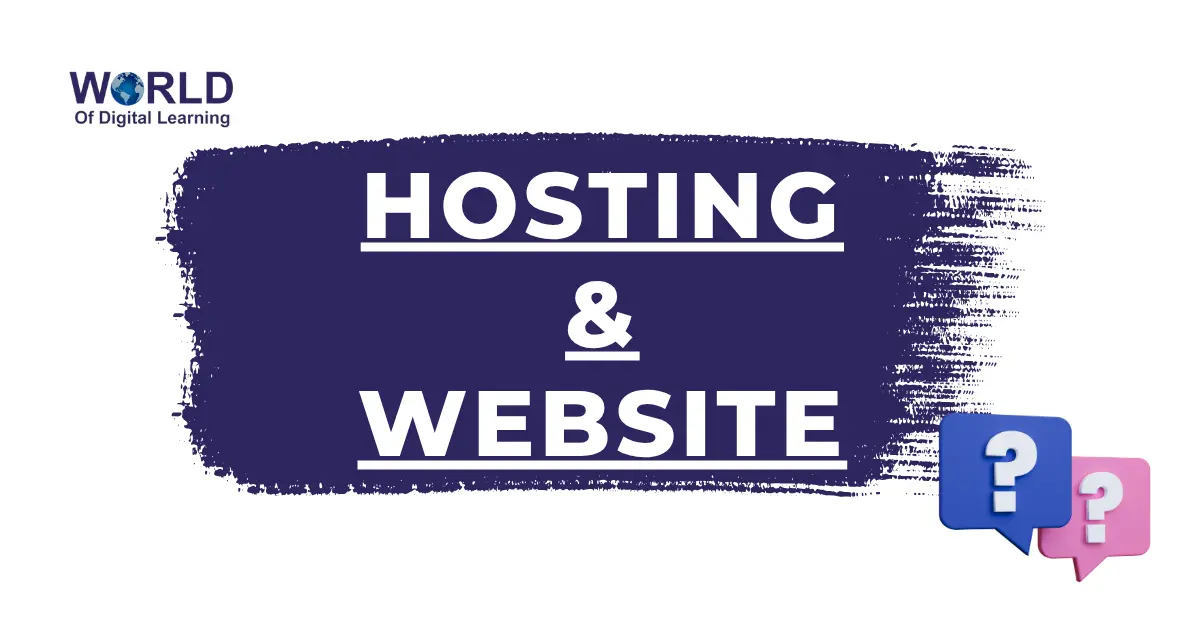Hosting & Website?
Hosting and website development go hand in hand to bring any online presence to life. A website is your digital identity, showcasing your services, products, or brand, while hosting provides the server space and technology to keep it accessible on the internet. Good web hosting ensures speed, security, and uptime, which are critical for user experience and search engine ranking. Whether it’s shared hosting for beginners, VPS for growing businesses, or dedicated servers for large enterprises, choosing the right hosting solution directly impacts website performance. Combined with a professional website design, reliable hosting helps you build credibility, engage audiences, and grow your digital footprint effectively.
Table of Contents
What is a Domain?
A domain is a unique, easy-to-remember address used to access a website on the internet, such as “google.com” or “facebook.com.” It acts like a website’s street address, allowing users to find the site without needing to remember complex numerical IP addresses. Domains consist of a name and a top-level domain (TLD) like .com, .org, or .net. To use a domain, one must register it through a domain registrar, which grants exclusive rights to use that domain for a set period. The domain name system (DNS) converts these domain names into IP addresses so browsers can load the correct website. In essence, a domain provides the identity and easy access point for online presence, separate from web hosting, which stores the website’s files.
What is Hosting & Server?
Hosting is a service that stores and maintains a website’s files on a physical or virtual computer called a server, making the website accessible on the internet. When a user enters a website’s domain into a browser, the hosting server delivers the necessary files to load the site. Servers are specialized computers that run continuously, designed for stability, speed, and handling multiple requests. They have hardware components like CPUs, RAM, and storage (often SSDs) and run server software such as Linux, Apache, or Nginx to process and serve website content efficiently. Essentially, while the server is the physical hardware where website data resides, hosting is the service that rents space on that server and manages the environment to keep the website online and accessible to visitors around the clock.
How to Host a Website on a Server
Hosting a website on a server involves several important steps to make your site accessible online. First, purchase a domain name, which is your site’s web address. Next, choose a reliable web hosting provider and select a hosting plan that fits your website’s needs and expected traffic. After purchasing hosting, configure your domain’s DNS settings to point to your hosting provider’s server by updating the nameservers. Then, upload your website files using an FTP client or your hosting control panel. If you use a content management system like WordPress, most hosts offer a one-click installation for easy setup. Once your files are uploaded, test your website on different devices and browsers to ensure everything works smoothly. Finally, after DNS propagation completes (usually 24–48 hours), your website will be live and accessible worldwide. Proper hosting ensures your site runs fast, stays secure, and remains available 24/7 to visitors.
How to Choose a Domain For the Business?
Choosing a domain name for a business is a crucial step in establishing a strong online identity. The domain should be short, memorable, and easy to spell to ensure customers can easily find and share your website. It’s best to use your brand or company name in the domain, keeping it relevant to your business niche. Avoid numbers, hyphens, and special characters as they can confuse users and are harder to remember. Incorporating keywords related to your products or services can improve SEO, but don’t overdo it; balance branding and keywords wisely. Select a suitable top-level domain (TLD) like .com for wider recognition or a country-specific TLD if targeting local customers. Also, consider your business’s future growth by choosing a flexible domain name that won’t limit your expansion. Checking domain availability early and securing privacy features protect your brand and personal information. A well-chosen domain builds trust, enhances marketing, and attracts the right audience effectively.
How to Create an Attractive Website on WordPress?
Creating an attractive website on WordPress involves several key steps to ensure it is visually appealing and user-friendly. Begin by defining your brand identity and selecting a suitable WordPress theme that aligns with your business’s style and target audience. Customize the theme’s colors, fonts, and logo to reflect your brand. Focus on creating a clean, organized layout with intuitive navigation so visitors can easily find information. Craft compelling, relevant content that speaks directly to your audience and use high-quality images and videos to enhance visual engagement. Optimize the website for mobile devices to ensure a seamless experience across all screen sizes. Additionally, use plugins smartly to add useful features without slowing down your site. Regularly update your website’s content and design based on user feedback and analytics to keep it fresh and relevant. Following these steps will help build a professional WordPress site that attracts visitors and encourages engagement.
How to Create Pages?
Creating pages in WordPress is a straightforward process that allows you to build various sections of your website, such as Home, About, and Contact. To create a new page, log in to your WordPress dashboard, navigate to the Pages section on the left menu, and click the “Add New” button. This opens the page editor, where you can enter a title and add content using the block editor, which supports text, images, videos, and other media blocks. Customize the page’s layout and settings as needed. Once ready, click the “Publish” button to make the page live on your site. You can add the page to your site’s navigation menu to help visitors easily find it. WordPress also allows creating subpages by selecting a parent page, organizing your content hierarchically. Pages can be edited at any time to update content or settings, providing flexibility in managing your website’s structure and information.
How to Create Post?
Creating a post in WordPress is simple and allows you to share updates, articles, or news on your website. To start, log in to your WordPress dashboard and navigate to the “Posts” section on the left menu. Click on “Add New” to open the post editor. Enter a catchy and relevant title in the title box. In the content area, use the block editor to add text, images, videos, and other media by clicking the “+” icon to insert different types of blocks. Format your content for readability with headings, lists, and links. You can assign categories and tags to organize your post and improve navigation. Once the post looks good, preview it to check for any errors or layout issues. When satisfied, click “Publish” to make your post live immediately or schedule it for a future date. This process helps you keep your audience engaged with fresh and organized content.
How to Choose and Upload Theme on WordPress?
Choosing and uploading a theme on WordPress is a key step in designing your website’s look and feel. First, select a theme that matches your business style and functional needs by browsing the WordPress theme directory within your dashboard under Appearance > Themes > Add New. Use filters like industry type and layout to find the perfect fit. You can preview themes to see how they will appear on your site. Once you decide, click “Install” and then “Activate” to apply the theme. If you have purchased or downloaded a premium theme, upload it by clicking “Upload Theme,” selecting the .zip file from your computer, then installing and activating it. After activation, customize your theme’s settings and appearance through the WordPress Customizer or the theme’s own options panel to tailor the site to your brand. This process makes your website visually appealing and user-friendly, enhancing visitor engagement.
How to Create a Contact Form on WordPress?
Creating a contact form on WordPress is easy and effective for connecting with your visitors. Start by installing a contact form plugin like WPForms, which is user-friendly and widely used. After installing and activating the plugin, go to WPForms in the WordPress dashboard and click “Add New” to create a new form. Choose a simple contact form template or start from scratch using the drag-and-drop builder. Customize the form by adding or editing fields such as name, email, phone, and message. After customization, save your form and copy its shortcode. To display the form on your site, create or edit a page, then paste the shortcode into the content area or use the WPForms block in the WordPress editor. Finally, publish the page, and your contact form will be live, making it easy for visitors to reach you directly through your website.
How to Create popup on WordPress?
Creating a popup on WordPress is a great way to capture visitor attention and increase engagement. Start by installing a popup plugin like Popup Maker or OptinMonster from the WordPress plugin directory and activate it. Once activated, go to the plugin’s menu in your WordPress dashboard and click “Add New Popup.” Give your popup a name and design it using the built-in editor, where you can add text, images, forms, or buttons. After designing, set triggers that determine when the popup appears, such as on page load, after a delay, or on exit intent. You can also configure where it displays, targeting specific pages or user actions. Customize the popup’s appearance and behavior to match your website’s style. Finally, save and publish your popup. This process creates an engaging, customized popup to help grow your email list, promote offers, or enhance user interaction on your site.

 September 25, 2025
September 25, 2025  9 Min
9 Min  No Comment
No Comment 